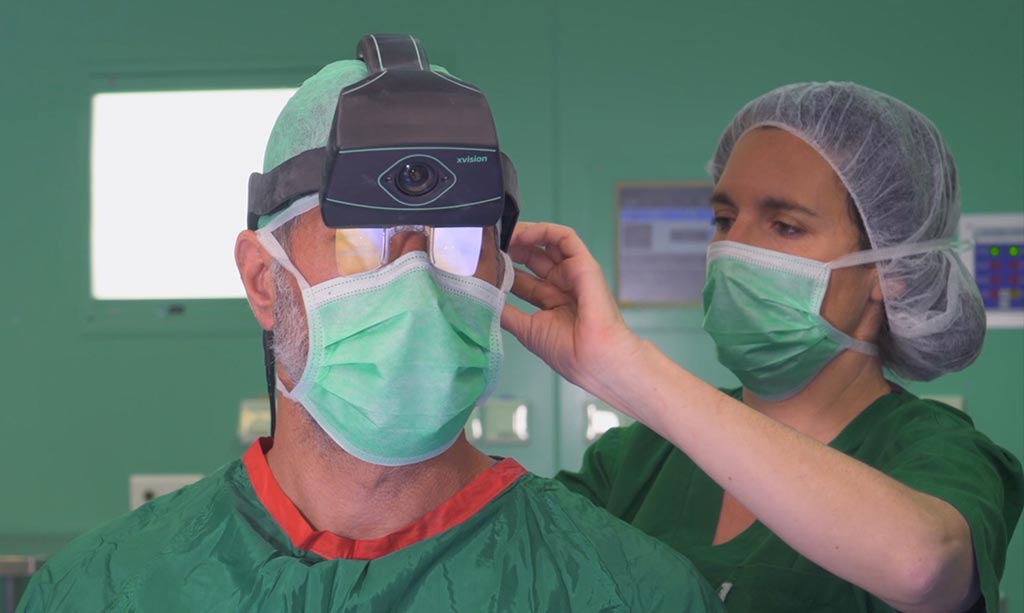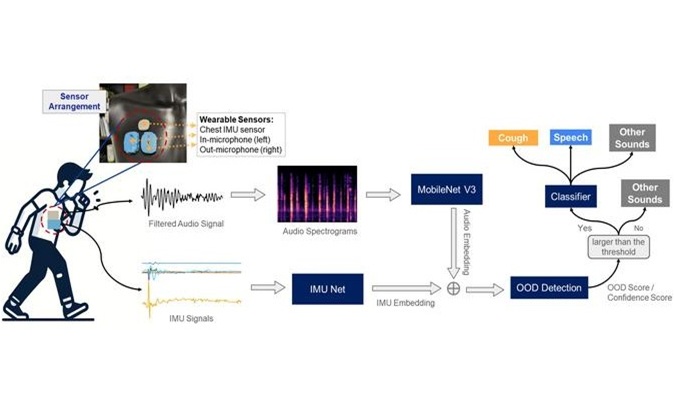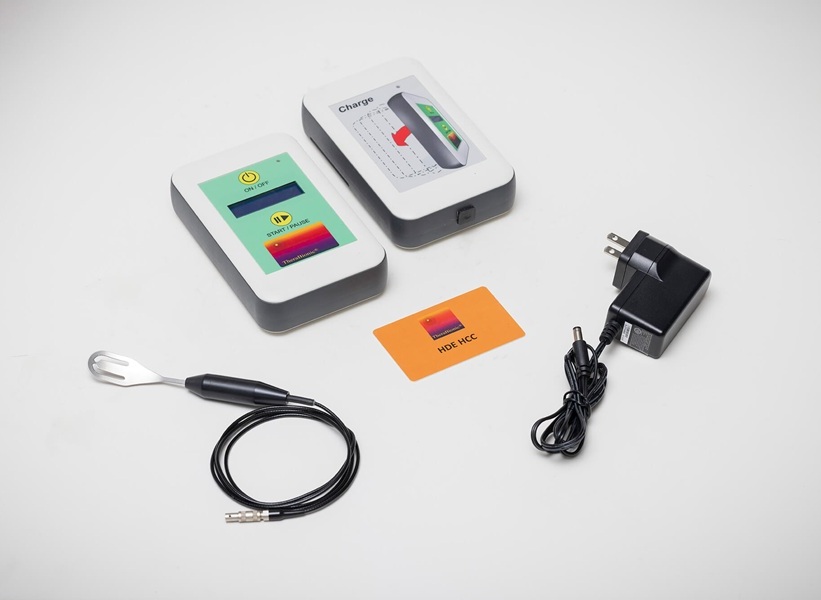AR Surgical System Enables See-Through Spine Surgery
|
By HospiMedica International staff writers Posted on 26 Apr 2018 |

Image: The XVS allows surgeons to see and navigate inside a patient’s body through skin and tissue, for easier, faster and safer surgeries (Photo courtesy of Augmedics).
Augmedics (Yoqneam, Israel), a developer of an augmented-reality (AR) surgical navigation system, has successfully completed its second cadaver study using its xvision-spine system (XVS) with surgeons from Johns Hopkins Hospital, as well as two surgeons from hospitals in Israel. During the study, the surgeons placed 120 pedicle screws in five separate cadavers with a screw placement accuracy of 96.7% when employing the combined Heary-Gertzbein grading scheme.
Augmedics’ XVS is an AR surgical navigation system designed to give surgeons “X-ray vision” during complex procedures. XVS allows surgeons to see and navigate inside a patient’s body through skin and tissue, for easier, faster and safer surgeries. The XVS system is comprised of a transparent near-eye-display headset and has all the elements of a traditional navigation system. It accurately determines the position of surgical tools in real-time and superimposes them on the patient's CT data. The navigation data is then projected onto the surgeons' retina using the transparent near-eye-display headset, allowing surgeons to simultaneously look at their patient and see the navigation data without averting their eyes to a remote screen.
XVS has the potential to be used in various procedures, with its first intended use in minimally invasive or open spine surgeries. The technology was designed to save time during surgery, increase precision in MISS and open spine surgeries, reduce radiation exposure, and reduce the number of unnecessary repeat operations and hospitalizations.
Dr. Timothy Witham, professor of neurological surgery and orthopedic surgery at the Johns Hopkins University School of Medicine, said, “Typically what we have to do during minimally-invasive spine surgery is we have to look away from where we’re working. But XVS has all the image-guided information directly in front of you in the goggles you’re wearing, while you’re placing the instrumentation.
“With XVS, I can actually see the details of the three-dimensional anatomy through the patient,” added Dr. Daniel Sciubba, professor of neurological surgery, oncology and orthopedic surgery at the Johns Hopkins University School of Medicine. “With its optics on-lay, it is lightweight, easy to use, and translucent, so you can see through the actual image.”
Related Links:
Augmedics
Augmedics’ XVS is an AR surgical navigation system designed to give surgeons “X-ray vision” during complex procedures. XVS allows surgeons to see and navigate inside a patient’s body through skin and tissue, for easier, faster and safer surgeries. The XVS system is comprised of a transparent near-eye-display headset and has all the elements of a traditional navigation system. It accurately determines the position of surgical tools in real-time and superimposes them on the patient's CT data. The navigation data is then projected onto the surgeons' retina using the transparent near-eye-display headset, allowing surgeons to simultaneously look at their patient and see the navigation data without averting their eyes to a remote screen.
XVS has the potential to be used in various procedures, with its first intended use in minimally invasive or open spine surgeries. The technology was designed to save time during surgery, increase precision in MISS and open spine surgeries, reduce radiation exposure, and reduce the number of unnecessary repeat operations and hospitalizations.
Dr. Timothy Witham, professor of neurological surgery and orthopedic surgery at the Johns Hopkins University School of Medicine, said, “Typically what we have to do during minimally-invasive spine surgery is we have to look away from where we’re working. But XVS has all the image-guided information directly in front of you in the goggles you’re wearing, while you’re placing the instrumentation.
“With XVS, I can actually see the details of the three-dimensional anatomy through the patient,” added Dr. Daniel Sciubba, professor of neurological surgery, oncology and orthopedic surgery at the Johns Hopkins University School of Medicine. “With its optics on-lay, it is lightweight, easy to use, and translucent, so you can see through the actual image.”
Related Links:
Augmedics
Latest Business News
- Philips and Masimo Partner to Advance Patient Monitoring Measurement Technologies
- B. Braun Acquires Digital Microsurgery Company True Digital Surgery
- CMEF 2025 to Promote Holistic and High-Quality Development of Medical and Health Industry
- Bayer and Broad Institute Extend Research Collaboration to Develop New Cardiovascular Therapies
- Medtronic Partners with Corsano to Expand Acute Care & Monitoring Portfolio in Europe
- Expanded Collaboration to Transform OR Technology Through AI and Automation
- Becton Dickinson to Spin Out Biosciences and Diagnostic Solutions Business
- Boston Scientific Acquires Medical Device Company SoniVie
- 2026 World Hospital Congress to be Held in Seoul
- Teleflex to Acquire BIOTRONIK’s Vascular Intervention Business
- Philips and Mass General Brigham Collaborate on Improving Patient Care with Live AI-Powered Insights
- Arab Health 2025 Celebrates Landmark 50th Edition
- Boston Scientific Acquires Medical Device Company Intera Oncology
- MEDICA 2024 to Highlight Hot Topics of MedTech Industry
- Start-Ups To Once Again Play Starring Role at MEDICA 2024
- Boston Scientific to Acquire AFib Ablation Company Cortex
Channels
Critical Care
view channel
Origami Robots to Deliver Medicine Less Invasively and More Effectively
Delivering medicine to ulcers or other internal sites often requires invasive procedures that can disrupt surrounding tissues and lengthen recovery times. Traditional magnetic actuators used in soft robotics... Read more
Improved Cough-Detection Technology Aids Health Monitoring
Coughing serves as an important biomarker for tracking a variety of conditions and can help monitor the progress of respiratory diseases or predict when someone’s asthma is being exacerbated.... Read moreSurgical Techniques
view channel
Novel Glue Prevents Complications After Breast Cancer Surgery
Seroma and prolonged lymphorrhea are among the most common complications following axillary lymphadenectomy in breast cancer patients. These postoperative issues can delay recovery and postpone the start... Read more
Breakthrough Brain Implant Enables Safer and More Precise Drug Delivery
Delivering medication directly to specific regions of the brain has long been a major challenge in treating neurological disorders. Current implants and infusion systems typically reach only one or two... Read morePatient Care
view channel
Revolutionary Automatic IV-Line Flushing Device to Enhance Infusion Care
More than 80% of in-hospital patients receive intravenous (IV) therapy. Every dose of IV medicine delivered in a small volume (<250 mL) infusion bag should be followed by subsequent flushing to ensure... Read more
VR Training Tool Combats Contamination of Portable Medical Equipment
Healthcare-associated infections (HAIs) impact one in every 31 patients, cause nearly 100,000 deaths each year, and cost USD 28.4 billion in direct medical expenses. Notably, up to 75% of these infections... Read more
Portable Biosensor Platform to Reduce Hospital-Acquired Infections
Approximately 4 million patients in the European Union acquire healthcare-associated infections (HAIs) or nosocomial infections each year, with around 37,000 deaths directly resulting from these infections,... Read moreFirst-Of-Its-Kind Portable Germicidal Light Technology Disinfects High-Touch Clinical Surfaces in Seconds
Reducing healthcare-acquired infections (HAIs) remains a pressing issue within global healthcare systems. In the United States alone, 1.7 million patients contract HAIs annually, leading to approximately... Read moreHealth IT
view channel
















